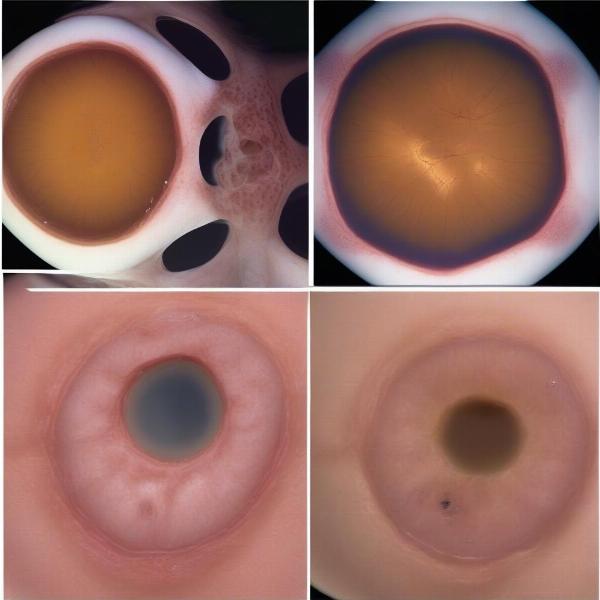Uveal cysts in dogs are fluid-filled sacs that develop within the uvea, the middle layer of the eye. While often benign and causing no noticeable symptoms, some uveal cysts can lead to complications requiring veterinary attention. Understanding the types, causes, symptoms, and treatment options for uveal cysts is essential for responsible dog ownership. This comprehensive guide will provide you with the information you need to ensure the best possible eye health for your canine companion.
Uveal cysts are categorized based on their location and appearance. Free-floating cysts move within the eye, while attached cysts are fixed to the iris or ciliary body. Pigmented cysts contain melanin, giving them a dark appearance, whereas non-pigmented cysts are typically translucent. The breed of your dog can also play a factor. Certain breeds, such as Golden Retrievers, Labrador Retrievers, and Boston Terriers, are more prone to developing these cysts.
 Different Types of Uveal Cysts in Dogs
Different Types of Uveal Cysts in Dogs
Identifying Uveal Cysts: Symptoms and Diagnosis
Many uveal cysts cause no noticeable symptoms, especially in their early stages. As cysts grow larger, they may cause visible changes in the eye’s appearance. These changes could include a visible mass in the eye, cloudiness, or changes in pupil shape. Sometimes, glaucoma or other secondary complications can develop, leading to more noticeable symptoms like pain, redness, and vision impairment. If you observe any unusual changes in your dog’s eyes, it’s crucial to consult a veterinarian immediately for a thorough eye examination. This examination often involves specialized equipment, such as an ophthalmoscope, to examine the internal structures of the eye and confirm the presence of cysts.
Understanding the Causes and Risk Factors
The exact causes of uveal cysts are not always clear. Genetic predisposition is thought to play a significant role, as certain breeds are more prone to developing them. Other potential factors include inflammation, injury, or developmental abnormalities within the eye. Age can also be a factor, with older dogs being more susceptible.
Treatment Options for Uveal Cysts
Most uveal cysts do not require treatment, especially if they are not causing any problems. Regular monitoring by a veterinarian is usually recommended to ensure the cysts are not growing or causing secondary complications. In cases where cysts are causing problems, such as glaucoma or vision impairment, treatment options may include medication to control intraocular pressure or, in rare cases, surgery to remove the cysts.
Living with Uveal Cysts: Monitoring and Long-Term Care
If your dog has been diagnosed with uveal cysts, regular veterinary check-ups are essential for monitoring their condition. This is particularly important for breeds predisposed to developing cysts or if the cysts are showing signs of growth. Maintaining open communication with your veterinarian is key to managing your dog’s eye health and addressing any potential complications promptly.
Conclusion
Uveal cysts in dogs are a condition that requires careful monitoring and understanding. While they are often benign, they can sometimes lead to serious complications if left unaddressed. By recognizing the symptoms, understanding the causes, and seeking appropriate veterinary care, you can help ensure the long-term eye health and well-being of your canine companion. Remember, early detection and regular monitoring are key to managing uveal cysts effectively.
FAQ
- What are the common signs of uveal cysts in dogs? Many uveal cysts have no visible symptoms. However, larger cysts may cause visible changes in the eye, such as a mass, cloudiness, or pupil shape changes.
- Are uveal cysts painful for dogs? Uveal cysts themselves are usually not painful. However, complications like glaucoma can cause pain, redness, and vision changes.
- Can uveal cysts be cured? While some cysts may resolve on their own, treatment is not always necessary. If complications arise, medication or surgery may be considered.
- How often should a dog with uveal cysts be seen by a vet? Regular check-ups are crucial, especially for breeds prone to cyst development or if the cysts are growing. Discuss the frequency with your veterinarian.
- Are there any preventative measures for uveal cysts? Unfortunately, there are no specific preventative measures, as genetic predisposition plays a significant role. Regular eye exams are the best way to detect and manage any potential issues early.
- Can uveal cysts cause blindness in dogs? While rare, complications from uveal cysts, such as glaucoma, can potentially lead to blindness if left untreated.
- Are uveal cysts contagious? No, uveal cysts are not contagious between dogs or to humans.
Related Articles
About ILM Dog
ILM Dog is your trusted source for expert advice on all aspects of dog care, from breed selection and puppy care to senior dog health and training. We’re dedicated to providing practical, reliable information to help dog owners worldwide provide the best possible care for their furry companions. Whether you’re a new dog owner or a seasoned expert, ILM Dog offers comprehensive resources on dog health, nutrition, behavior, and more. We specialize in providing tailored advice based on your dog’s specific needs, covering everything from breed-specific health concerns to the latest in veterinary care. Contact us at [email protected] or +44 20-3965-8624 for personalized guidance.